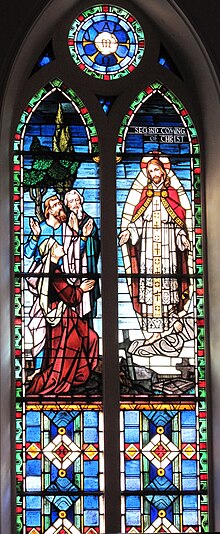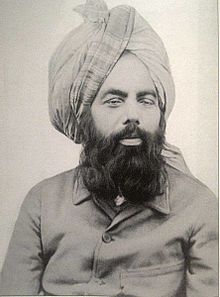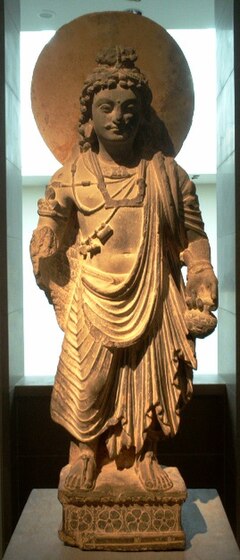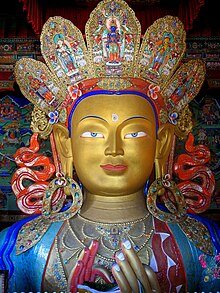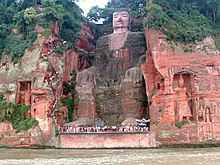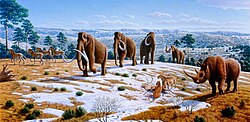Greek icon of Second Coming, c.1700
The Second Coming (sometimes called the Second Advent or the Parousia) is a Christian and Islamic belief regarding the future (or past) return of Jesus after his ascension to heaven about two thousand years ago. The idea is based on messianic prophecies and is part of most Christian eschatologies.
Views about the nature of Jesus's Second Coming vary among Christian denominations and among individual Christians.
Terminology
Several different terms are used to refer to the Second Coming of Christ:
In the New Testament, the Greek word ἐπιφάνεια (epiphaneia, appearing) is used five times to refer to the return of Christ.
The Greek New Testament uses the Greek term parousia
(παρουσία, meaning "arrival", "coming", or "presence") twenty-four
times, seventeen of them concerning Christ. However, parousia has the
distinct reference to a period of time rather than an instance in time.
At Matthew 24:37 parousia is used to clearly describe the period of time
that Noah lived. The Greek word eleusis which means "coming" is
not interchangeable with parousia. So this parousia or "presence" would
be unique and distinct from anything that had occurred before. The word is also used six times referring to individuals (Stephanas, Fortunatus and Achaicus, Titus, and Paul the Apostle) and one time referring to the "coming of the lawless one".
Gustav Adolf Deissmann (1908) showed that the Greek word parousia
occurred as early as the 3rd century BC to describe the visit of a king
or dignitary to a city - a visit arranged in order to show the
visitor's magnificence to the people.
Last Day counterfeits
Some Christian writings say that there will be a great deception
before the Second Coming of Christ. In Matthew 24, Jesus states in the
following passage:
If anyone says to you then, 'Look, here is the Messiah!' or, 'There he is!' do not believe it. False messiahs and false prophets will arise, and they will perform signs and wonders so great as to deceive, if that were possible, even the elect.
— Matthew 24:21, 24 (NAB)
Ellen G. White, the early Seventh-day Adventist leader, wrote:
As the crowning act in the great drama of deception, Satan himself will impersonate Christ. The church has long professed to look to the Saviour's advent as the consummation of her hopes. Now the great deceiver will make it appear that Christ has come. In different parts of the earth, Satan will manifest himself among men as a majestic being of dazzling brightness, resembling the description of the Son of God given by John in the Revelation. (Revelation 1:13-15). The glory that surrounds him is unsurpassed by anything that mortal eyes have yet beheld. The shout of triumph rings out upon the air: "Christ has come! Christ has come!" The people prostrate themselves in adoration before him, while he lifts up his hands and pronounces a blessing upon them, as Christ blessed His disciples when He was upon the earth. His voice is soft and subdued, yet full of melody. In gentle, compassionate tones he presents some of the same gracious, heavenly truths which the Saviour uttered; he heals the diseases of the people, and then, in his assumed character of Christ, he claims to have changed the Sabbath to Sunday, and commands all to hallow the day which he has blessed.
— The Great Controversy, p. 624
Specific date predictions and claims
A number of specific dates have been predicted for the Second Coming
of Christ, some now in the distant past, others still in the future.
Christian eschatological views
Most English versions of the Nicene Creed include the following statements:
...he ascended into heaven and is seated at the right hand of the Father. He will come again in his glory to judge the living and the dead, and his kingdom will have no end. ... We look for the resurrection of the dead, and the life of the world to come.
Early Christianity
Jesus was reported to have told his disciples,
Truly I tell you, this generation will certainly not pass away until all these things have happened.
Given that in his next statement Jesus notes that the exact day and
hour is unknown even to himself, the simple meaning of his previous
statement is that the Second Coming was to be witnessed by people
literally living in that same generation. Some, such as Jerome, interpret the phrase "this generation" to mean in the lifetime of the Jewish race; however, other scholars believe that if Jesus meant "race" he would have used genos (race), not genea (generation).
Victor J. Stenger notes that Jesus is recorded as saying,
...there are some standing here, which shall not taste death, till they see the Son of Man coming in his kingdom "
He makes similar predictions in five other places in the Gospels; Mark 9:1, Mark 13:30, Matt 24:34, Luke 9:27, Luke 21:32.
In Stenger's view, when the coming did not happen within the life-times
of his disciples, as Jesus prophesied, Christianity changed its
emphasis to the resurrection and promise of eternal life.
According to historian Charles Freeman, early Christians
expected Jesus to return within a generation of his death and the
non-occurrence of the second coming surprised the early Christian
communities.
Children, it is the last hour; and just as you heard that Antichrist is coming, even now many antichrists have appeared; from this we know that it is the last hour.
Preterism
The position associating the Second Coming with 1st century events such as the destruction of Jerusalem and of the Jewish Temple in AD 70 is known as Preterism.
Some Preterists see this "coming of the Son of Man in glory"
primarily fulfilled in Jesus' death on the cross. They believe the
apocalyptic signs are already fulfilled including "the sun will be dark" (cf. Mark 13:24-15:33), the "powers ... will be shaken," (cf. Mark 13:25-14:63, 15:5) and "then they will see" (cf. Mark 13:26-15:31, 15:39).
Yet some critics note that many are missing, such as "But the day of
the Lord will come as a thief in the night, in which the heavens will
pass away with a great noise, and the elements will melt with fervent
heat; both the earth and the works that are in it will be burned up." (2 Peter 3:10).
And "Then the sign of the Son of Man will appear in heaven, and then
all the tribes of the earth will mourn, and they will see the Son of Man
coming on the clouds of heaven with power and great glory." (Matthew 24:30)
Catholic and Orthodox
The Last Judgment by Michelangelo (1541) in the Sistine Chapel, Rome.
It is the traditional view of Roman Catholics and Orthodox Christians,
preserved from the early Church, that the second coming will be a
sudden and unmistakable incident, like "a flash of lightning". They hold the general view that Jesus will not spend any time on the earth in ministry or preaching, but come to judge mankind. They also agree that the ministry of the Antichrist will take place right before the Second Coming.
Many Christian denominations consider this second coming of Christ to be the final and eternal judgment by God of the people in every nation resulting in the glorification of some and the punishment of others. The concept is found in all the Canonical gospels, particularly the Gospel of Matthew.
A decisive factor in this Last Judgement during the second coming of Christ will be the question, if the corporal and spiritual works of mercy
were practiced or not during lifetime. They rate as important acts of
mercy, charity and justice. Therefore, and according to the biblical
sources (Mt 5:31-46), the conjunction of the Last Judgement and the works of mercy is very frequent in the pictorial tradition of Christian art.
Orthodox layman Alexander Kalomiros explains the original Church's position regarding the Second Coming in River of Fire and Against False Union,
stating that those who contend that Christ will reign on earth for a
thousand years "do not wait for Christ, but for the Antichrist." The
idea of Jesus returning to this earth as a king is a heretical concept
to the Church, equated to "the expectations of the Jews who wanted the
Messiah to be an earthly King." The Church instead teaches that which it
has taught since the beginning—Christ will not return to earth, rather the Kingdom of Heaven, the New Jerusalem, will be established through the resurrection of the dead.
According to the Catholic church, the second coming will bring
about the fullness of the reign of God and the consummation of the universe, mankind, and salvation. The Catholic church believes there are three things that hasten the return of Jesus: the transforming power of the Holy Spirit in the liturgy; living with the mind of Jesus; and praying for the Lord to come, above all in the Eucharist.
Protestant
The Second Coming of Christ stained glass window at St. Matthew's German Evangelical Lutheran Church in Charleston, South Carolina, United States.
The many denominations of Protestantism
have differing views on the exact details of Christ's second coming.
Only a handful of Christian organizations claim complete and
authoritative interpretation of the typically symbolic and prophetic
biblical sources.
A short reference to the second coming is contained in the Nicene
Creed: "He [Jesus] shall come again in glory to judge the living and
the dead; and His kingdom shall have no end." An analogous statement is
also in the biblical Pauline Creed (1Cor 15:23).
Some Protestant churches proclaim the Mystery of Faith to be: "Christ has died, Christ is risen, Christ will come again."
The Church of Jesus Christ of Latter-day Saints
Latter-day Saints have particularly distinct and specific interpretations of what are considered to be signs stated in the Book of Revelation. Their scriptures
say that Christ will return, as stated in the Bible. Their church also
teaches that "When the Savior comes again, He will come in power and
glory to claim the earth as His kingdom. His Second Coming will mark the
beginning of the Millennium. The Second Coming will be a fearful,
mournful time for the wicked, but it will be a day of peace for the
righteous."
Seventh-day Adventists
Fundamental Belief #25 of the Seventh-day Adventist Church states:
The second coming of Christ is the blessed hope of the church, the grand climax of the gospel. The Saviour's coming will be literal, personal, visible, and worldwide. When He returns, the righteous dead will be resurrected, and together with the righteous living will be glorified and taken to heaven, but the unrighteous will die. The almost complete fulfillment of most lines of prophecy, together with the present condition of the world, indicates that Christ's coming is imminent. The time of that event has not been revealed, and we are therefore exhorted to be ready at all times. (Titus 2:13; Heb. 9:28; John 14:1-3; Acts 1:9-11; Matt. 24:14; Rev. 1:7; Matt. 24:43, 44; 1 Thess. 4:13-18; 1 Cor. 15:51-54; 2 Thess. 1:7-10; 2:8; Rev. 14:14-20; 19:11-21; Matt. 24; Mark 13; Luke 21; 2 Tim. 3:1-5; 1 Thess. 5:1-6.)
Jehovah's Witnesses
Jehovah's Witnesses rarely use the term "second coming", preferring the term "presence" as a translation of parousia. They believe that Jesus' comparison of "the presence of the Son of man" with "the days of Noah" at Matthew 24:37–39 and Luke 17:26–30 suggests a duration rather than a moment of arrival. They also believe that biblical chronology points to 1914 as the start of Christ's "presence", which continues until the final battle of Armageddon.
Other biblical expressions they correlate with this period include "the
time of the end" (Dan 12:4), "the conclusion of the system of things"
(Matt 13:40,49; 24:3) and "the last days" (2 Tim 3:1; 2 Peter 3:3). Witnesses believe Christ's millennial reign begins after Armageddon.
Christian fundamentalism
A
recent survey (2010) showed that about 40% of Americans believe that
Jesus is likely to return by 2050. This varies from 58% of white
evangelical Christians, through 32% of Catholics to 27% of white
mainline Protestants.
Belief in the Second Coming was popularised in the US in the late nineteenth century by the evangelist Dwight L. Moody and the premillennial interpretation became one of the core components of Christian fundamentalism in the 1920s.
Esoteric Christian teachings
In Rosicrucian esoteric Christian teaching, there is a clear distinction between the cosmic Christ, or Christ without, and the Christ within. According to this tradition, the Christ within is regarded as the true Saviour who needs to be born within each individual in order to evolve toward the future Sixth Epoch in the Earth's etheric plane, that is, toward the "new heavens and a new earth": the New Galilee. The Second Coming or Advent of the Christ is not in a physical body, but in the new soul body of each individual in the etheric plane of the planet where man "shall be caught up in the clouds to meet the Lord in the air." The "day and hour" of this event is not known. The esoteric Christian tradition teaches that first there will be a preparatory period as the Sun enters Aquarius, an astrological concept, by precession: the coming Age of Aquarius.
Islam
Traditional view
In Islam, Jesus (or Isa; Arabic: عيسى ʿĪsā) is considered to be a Messenger of God and the Masih (messiah) who was sent to guide the Israelites (banī isrā'īl) and Gentiles with a new scripture, the Injīl. The belief in Jesus (and all other messengers of God) is required in Islam, and a requirement of being a Muslim. However, Muslims do not recognize Jesus as the Son of God, as they believe God has no equals, but instead as a prophet. The Quran states that Jesus was born of the Virgin Mary. Muslims believe that Jesus performed all the miracles in the Gospels, but do not believe that Jesus was crucified.
In the Quran, the second coming of Jesus is heralded in Az-Zukhruf (the Quran's 43rd surah or chapter) as a sign of the Day of Judgment.
And (Jesus) shall be a Sign (for the coming of) the Hour (of Judgment): therefore have no doubt about the (Hour), but follow ye Me: this is a Straight Way. 43:61
In his famous interpretation of the Quran or Tafsir al-Qur'an
al-Azim, Ibn Kathir also uses this verse as proof of Jesus' second
coming in the Quran.
There are also hadiths that clearly foretell of Jesus' future return such as: Sahih al-Bukhari, Volume 3, Book 43: Kitab-ul-`Ilm (Book of Knowledge), Hâdith Number 656:
The Hour will not be established until the son of Mary (i.e. Jesus) descends amongst you as a just ruler, he will break the cross (idol symbol of Christians), kill the pigs, and abolish the Jizya tax. Money will be in abundance so that nobody will accept it (as charitable gifts).
According to Islamic tradition, Jesus' descent will be in the midst of wars fought by the Mahdi (lit. "the rightly guided one"), known in Islamic eschatology as the redeemer of Islam, against the Masih ad-Dajjal (literally "false messiah", synonymous with the Antichrist) and his followers. Jesus will descend at the point of a white arcade, east of Damascus, dressed in saffron robes—his head anointed. He will then join the Mahdi in his war against the Dajjal.
Jesus, considered in Islam as a Muslim (one who submits to God) and one
of God's messengers, will abide by the Islamic teachings. Eventually,
Jesus will slay the Antichrist Dajjal, and then everyone from the People of the Book (ahl al-kitāb, referring to Jews and Christians) will believe in him. Thus, there will be one community, that of Islam. Sahih Muslim, 41:7023
After the death of the Mahdi, Jesus will assume
leadership. This is a time associated in Islamic narrative with
universal peace and justice. Islamic texts also allude to the appearance
of Ya'juj and Ma'juj
(known also as Gog and Magog), ancient tribes which will disperse and
cause disturbance on earth. God, in response to Jesus's prayers, will
kill them by sending a type of worm in the napes of their necks.
Jesus's rule is said to be around forty years, after which he will die,
(according to Islam Jesus did not die on the cross but was taken up to
heaven and continues to live until his return in the second coming).
Muslims will then perform the Salat al-Janazah (funeral prayer) for him and bury him in the city of Medina in a grave left vacant beside Muhammad.
Ahmadiyya
The Ahmadi sect, who identify as Muslims, believe that the promised Mahdi and Messiah arrived in the person of Mirza Ghulam Ahmad (1835–1908). This is rejected by many Muslims, who consider the Ahmadiyya not to be Muslims.
The hadith (sayings of the Islamic Prophet Muhammad) and the Bible
indicated that Jesus would return during the latter days. Islamic
tradition commonly depicts that Jesus, upon his second coming, would be
an Ummati (Muslim) and a follower of Muhammad and that he would revive the truth of Islam rather than fostering a new religion.
The Ahmadiyya movement interpret the Second Coming of Jesus prophesied as being that of a person "similar to Jesus" (mathīl-i ʿIsā) and not his physical return, in the same way as John the Baptist resembled the character of the biblical prophet Elijah
in Christianity. Ahmadis believe that Ghulam Ahmad demonstrated that
the prophecy in Muslim and Christian religious texts were traditionally
misunderstood to suggest that Jesus of Nazareth himself would return,
and hold that Jesus had survived the crucifixion
and had died a natural death. Ahmadis consider Mirza Ghulam Ahmad (the
founder of the movement), in both his character and teachings, to be
representative of Jesus; and subsequently, he attained the same
spiritual rank of Prophethood as Jesus. Thus, Ahmadis believe this
prediction was fulfilled and continued by his movement.
Other views and commentaries
Baha'i Faith
Bahá'u'lláh
announced that the return of Christ, understood as a reappearance of
the Word and Spirit of God, was manifest in his person. Baha'u'llah
wrote to Pope Pius IX,
He Who is the Lord of Lords is come overshadowed with clouds...He, verily, hath again come down from Heaven even as He came down from it the first time. Beware that thou dispute not with Him even as the Pharisees disputed with Him without a clear token or proof.
He goes on to refer to himself as the Ancient of Days and the Pen of Glory. Baha'u'llah also said in this connection:
This is the Father foretold by Isaiah, and the Comforter concerning Whom the Spirit had covenanted with you. Open your eyes, O concourse of bishops, that ye may behold your Lord seated upon the Throne of might and glory.
Baha'u'llah also wrote,
Say: We, in truth, have given Ourself as a ransom for your own lives. Alas, when We came once again, We beheld you fleeing from Us, whereat the eye of My loving-kindness wept sore over My people."
Followers of the Bahá'í Faith believe that the fulfillment of the prophecies of the second coming of Jesus, as well as the prophecies of the Maitreya and many other religious prophecies, were begun by the Báb in 1844 and then by Bahá'u'lláh.
They commonly compare the fulfillment of Christian prophecies to Jesus'
fulfillment of Jewish prophecies, where in both cases people were
expecting the literal fulfillment of apocalyptic statements. Bahá'ís
claim that the return of Christ with a new name parallels the return of
Elijah in John the Baptist as stated by Jesus in the Gospels.
Judaism
Judaism believes that Jesus is one of the false Jewish Messiah claimants because he failed to fulfill any Messianic prophecies, which include:
- Build the Third Temple (Ezekiel 37:26-28).
- Gather all Jews back to the Land of Israel (Isaiah 43:5-6).
- Usher in an era of world peace, and end all hatred, oppression, suffering and disease. As it says: "Nation shall not lift up sword against nation, neither shall man learn war anymore." (Isaiah 2:4)
- Spread universal knowledge of the God of Israel, which will unite humanity as one. As it says: "God will be King over all the world ― on that day, God will be One and His Name will be One" (Zechariah 14:9).
Regarding the Christian idea that these prophecies will be fulfilled during a "second coming," Ohr Samayach
states "we find this to be a contrived answer, since there is no
mention of a second coming in the Jewish Bible. Second, why couldn't God
accomplish His goals the first time round?" Rabbi David Wolpe
believes that the Second Coming was "grown out of genuine
disappointment. [...] When Jesus died, true believers had to
theologically compensate for the disaster."
Rastafari
In the early developments of the Rastafari religion, Haile Selassie (the Ethiopian Emperor) was regarded as a member of the House of David, is worshipped as God incarnate, and is thought to be the "black Jesus" and "black messiah" - the second coming of Christ. It was claimed that Marcus Garvey
preached the coming of the black messiah on the eve of Selassie's
coronation. Due to this prophecy, Selassie was the source of inspiration
of the poor and uneducated Christian populations of Jamaica, who believed that the Emperor would liberate the black people from the subjugation of European colonists.
Paramahansa Yogananda's commentary
In modern times some traditional Indian religious leaders have moved to embrace Jesus as an avatar, or incarnation, of God. In light of this, the Indian guru Paramahansa Yogananda, author of Autobiography of a Yogi, wrote an extensive commentary on the Gospels published in 2004 in the two-volume set The Second Coming of Christ: The Resurrection of the Christ Within You.
The book offers a mystical interpretation of the Second Coming in which
it is understood to be an inner experience, something that takes place
within the individual heart. In the introduction of this book, Yogananda
wrote that the true Second Coming is the resurrection within you of the
Infinite Christ Consciousness. Also stated in the Book of Luke -
"Neither shall they say, Lo here! or, lo there! for, behold, the kingdom
of God is within you." (Luke 17:21)
Daya Mata wrote in the preface of The Second Coming of Christ
that the "two-volume scriptural treatise thus represents the inclusive
culmination of Paramahansa Yogananda's divine commission to make
manifest to the world the essence of original Christianity as taught by
Jesus Christ." In sharing her memories of when she wrote down his
words, she shares - "the great Guru, his face radiantly enraptured, as
he records for the world the inspired exposition of the Gospel teachings
imparted to him through direct, personal communion with Jesus of
Nazareth." Larry Dossey, M.D., wrote that "Paramahansa Yogananda’s The Second Coming of Christ
is one of the most important analyses of Jesus’ teachings that
exists....Many interpretations of Jesus’ words divide peoples, cultures,
and nations; these foster unity and healing, and that is why they are
vital for today’s world."
In modern culture
Jesus Christ returning to earth has been a theme in several movies and books, for example:
- The Seventh Sign - 1988 film starring Demi Moore about a pregnant lady who discovers the Second Coming of Christ has rented a room from her, in order to begin the countdown that will trigger the Apocalypse.
- Left Behind - Film- and book-franchise (1995- ) built by Tim LaHaye and Jerry B. Jenkins based on the time-period before, during and after the Second Coming of Christ.
- End of Days - 1999 action-adventure film starring Arnold Schwarzenegger about a policeman who must stop Satan before he ends the world.
- Thief In the Night by William Bernard Sears - The popular TV and radio personality plays the role of a detective in writing a book about identifying the clues and symbols from the Biblical prophecies of the return of the Christ that have been overlooked or misunderstood, and settles on a shocking conclusion (2002) [1961]. Oxford, UK: George Ronald. ISBN 0-85398-008-X.
- SCARS: Christian Fiction End-Times Thriller by Patience Prence - 2010 novel about a girl named Becky who struggles through the time of the Great Tribulation.
- At the End of All Things by Stony Graves - 2011 novel about the days following the Rapture, and right before the Final War between God and Satan.
- The Second Coming: A Love Story by Scott Pinsker - 2014 novel about two men who claim to be the Second Coming of Christ. Each claims that the other is a liar - but only one is telling the truth.
- Black Jesus - Comedy Central Adult Swim Television Series (2014- ) created by Aaron McGruder and Mike Clattenburg, tells the story of Jesus living in modern-day Compton, California, and his efforts to spread love and kindness on a daily basis. He is supported in his mission by a small-but-loyal group of downtrodden followers, while facing conflicts involving corrupt preachers, ethnic tensions, and the hate spreading activities of the manager of his apartment complex.
- Mr. Robot - USA Network television series (2015- ), uses visual and verbal references to biblical figures and events based on The Second Coming.

